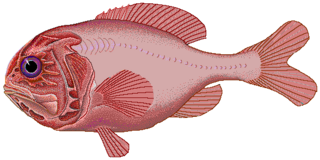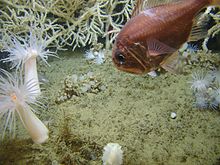
The Beryciformes are a poorly-understood order of carnivorous ray-finned fishes consisting of 7 families, 30 genera, and 161 species. They feed on small fish and invertebrates. Beyond this, little is known about the biology of most member species because of their nocturnal habits and deepwater habitats. All beryciform species are marine and most live in tropical to temperate, deepwater environments. Most live on the continental shelf and continental slope, with some species being found as deep as 2,000 m (6,600 ft). Some species move closer to the surface at night, while others live entirely in shallow water and are nocturnal, hiding in rock crevices and caves during the day. Several species are mesopelagic and bathypelagic. Beryciformes' bodies are deep and mildly compressed, typically with large eyes that help them see in darker waters. Colors range from red to yellow and brown to black, and sizes range from 8–61 cm (3.1–24.0 in). Member genera include the alfonsinos, squirrelfishes, flashlight fishes, fangtooth fishes, spinyfins, pineconefishes, redfishes, roughies, and slimeheads. A number of member species are caught commercially, including the alfonsino, the splendid alfonsino, and the orange roughy, the latter being much more economically important. Some species have bioluminescent bacteria contained in pockets of skin or in light organs near the eyes, including the anomalopids and monocentrids.

The orange roughy, also known as the red roughy, slimehead and deep sea perch, is a relatively large deep-sea fish belonging to the slimehead family (Trachichthyidae). The UK Marine Conservation Society has categorized orange roughy as "vulnerable to exploitation". It is found in 3 to 9 °C, deep waters of the Western Pacific Ocean, eastern Atlantic Ocean, Indo-Pacific, and in the eastern Pacific off Chile. The orange roughy is notable for its extraordinary lifespan, attaining over 200 years. It is important to commercial deep-trawl fisheries. The fish is a bright, brick-red color, fading to a yellowish-orange after death.

Slimeheads, also known as roughies and redfish, are mostly small, exceptionally long-lived, deep-sea beryciform fish constituting the family Trachichthyidae. Found in temperate to tropical waters of the Atlantic, Indian, and Pacific Oceans, the family comprises about 50 species in eight genera. Slimeheads are named for the network of muciferous canals riddling their heads.
The South Tasman Rise is an area of seafloor that lies 550 km south of Hobart, Tasmania in the Southern Ocean where water depths are about 1,500 metres. The South Tasman Rise is also known as the Tasmania Ridge or South Tasmania Ridge. The South Tasman Rise is a sunken landbridge that used to connect Tasmania to Antarctica.

The silver roughy or Mediterranean slimehead is a small deep-sea fish species belonging to the slimehead family (Trachichthyidae). It is found widely at depths of 100 to 1,175 m (328–3,855 ft) in the Atlantic, ranging from Iceland and Georges Bank in the north to South Africa and Brazil in the south, including the Mediterranean and Gulf of Mexico. It is also found in the Western Indian Ocean, including the Red Sea.

Orange Roughies is a New Zealand television drama created by Auckland-based film company Screenworks, the first season of which was screened on TV ONE from May to July 2006. The second season was due to be shown some time between October 2006 and January 2007, but due to poor ratings the programme was taken off the air.

The Graveyard Seamounts, officially known as the Graveyard Knolls, are a series of 28 small seamounts and edifices located on the Chatham Rise, east of New Zealand. They cover about 140 km2 (54 sq mi) and stand out from the surrounding oceanic plateau that measures several hundred kilometers. They are named after various morose figures following the naming of the largest of the knolls as "the Graveyard" as it was a graveyard of fishing gear that became stuck on it. The most prominent among the group of knolls are Ghoul, Diabolical, Voodoo, Scroll, Hartless, Pyre, Gothic, Zombie, Mummy, Headstone, Morgue and Graveyard.

Hoplostethus is a genus of fish in the slimehead family.
Hoplostethus rubellopterus, is a small deep-sea fish species belonging to the slimehead family (Trachichthyidae).
The Chilean roughy is a slimehead native to the Valparaíso region of Chile in the southeast Pacific. It lives at depths between 250 and 350 m. It has been known to contain high levels of mercury.

Gwen Fenton was the Chief Scientist of the Australian Antarctic Division and is the first woman to hold this position. She discovered that the fish species Hoplostethus atlanticus can live to over 100 years old, leading to significant changes to the management of the species.
The Western Pacific roughy is a species of slimehead found in the Northwest Pacific along Japan's southern coast in Sagami Bay, Suruga Bay, and the Sea of Japan. It can reach up to 12.6 cm (5.0 in) SL and its depth range is 336–605 m (1,102–1,985 ft).
The Red Sea roughy is a slimehead of the order Beryciformes. It is found in the Western Indian Ocean and the Red Sea at depths of up to 520 m (1,710 ft). It can reach sizes of up to 12.2 cm (4.8 in) SL. The species is known from only five specimens.
The New Zealand giant sawbelly is a slimehead of the order Beryciformes. It is native to the South Pacific, more specifically the sub-tropical and temperate latitudes of the Tasman and South Fiji basins. It is also found along Australia's southeastern coast, the Bay of Plenty, and southern Kermadec Ridge at the north end of New Zealand's North Island. It can reach sizes of up to 51.5 cm (20.3 in) SL. Its natural habitats are "continental slopes, seamounts, and submarine rises" between 250–400 m (820–1,310 ft), though it has been found as shallow as 140 metres (460 ft) and as deep as 760 m (2,490 ft). The first H. melanopeza caught were thought to be individuals of the H. gigas species, and it was not distinguished as a separate species until much later. One key difference between the two is that although both are red, H. melanopeza has black fin margins.
The blackfin roughy is a slimehead of the order Beryciformes. It has a very wide distribution across the Atlantic, Pacific, and Indian Oceans. It can reach sizes of up to 14.0 cm (5.5 in) TL. It is a deepwater fish, living between 454–1,500 m (1,490–4,921 ft) deep.
The metallic roughy is a slimehead of the order Beryciformes. It is native to the Western Central Pacific along the eastern seaboard of Negros Island in the Philippines and other locations in the Sulu Sea. It has a deep-water range of 55–550 m (180–1,804 ft). It is known from only 25 collected specimens, but members of this genus are known to frequently be "locally abundant," occurring in dense schools over seamounts.
The eastern Pacific roughy is a slimehead of the order Beryciformes. It is found in the Southeast Pacific from Ecuador and the Galápagos Islands to Peru. It can be found as deep as 703 m (2,306 ft).
The thickspine roughy is a slimehead of the order Beryciformes. It is native to the Northwestern Pacific near the Philippines and Japan where it can be found as deep as 660 m (2,170 ft). It can reach sizes of up to 35.4 cm (13.9 in) SL.
Dianne Margaret Tracey is a New Zealand marine biologist specializing in research on deep-sea fisheries and deep-sea corals at the National Institute of Water and Atmospheric Research (NIWA). She works on the biology of deep water fishes such as orange roughy, and deep sea corals. She was one of the first women in New Zealand to work in fisheries and to work on research vessels and has spent her career advocating and mentoring women in marine science.







